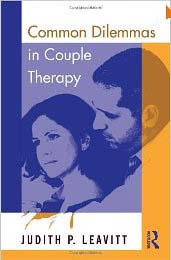Common Dilemmas in Couple Therapy

Author guides readers through menu of techniques
(February 2011 Issue)
“Common Dilemmas in Couple Therapy”
By Judith P. Leavitt Routledge
New York, N.Y., 2010
By Paul Efthim, Ph.D.
This intriguing text takes a different approach than most books on couple therapy. Rather than presenting a model of couple treatment linked to one particular theoretical viewpoint, this new book by Judith Leavitt offers a technically eclectic overview of strategies for working with specific issues in relationship therapy.
Leavitt, a psychologist and certified sex therapist who maintains a private practice in Wayland, Mass., teaches couple therapy and human sexuality at the Massachusetts School of Professional Psychology.
Her guidebook focuses on a quartet of problem areas that frequently arise in couple therapy: working with difficult partners; dealing with secrets; treating partners who can’t or won’t change; and handling breakups.
Each of these four areas gets its own 50-page section with detailed reflections and nuts-and-bolts guidance on how to assess and treat couples who are stuck or struggling. Within each section, separate chapters outline the dynamics of each dilemma, offer strategic options and discuss the therapist’s own emotional reactions and roles in doing this challenging work. At the close of each section, an extensive bibliography provides direction for further reading.
One of the strengths of this volume is its willingness to tackle the question “What the heck do I do?” in challenging clinical situations. Drawing on strategic family therapy, gestalt and cognitive-behavioral approaches, Leavitt guides the reader through a menu of techniques that can be applied at particular points in treatment.
For example, in the face of difficult partners’ efforts to control, blame their partner and disown their role in the problem, the author suggests strategies to help these individuals become less defensive and more workable. To this end, Leavitt proposes an interesting typology of difficult partner styles, including the offensive partner, the defensive partner, the victim, the avoider and so on. Depending on the person’s defensive style, different approaches are recommended, such as paradoxical interventions, working with the non-problem partner and empathy-deepening techniques.
Clinicians who are new to couple treatment will appreciate how the author normalizes the strong emotions stirred up in the work, as well as the detailed attention to clinical decision-making in order to sort out what approaches to consider, with which patients, at what particular stage of the treatment. More seasoned couple therapists may find some new ideas for working with vexingly familiar problems.
The book’s eclecticism is both an asset and a drawback. Leavitt pulls in a wide range of perspectives but as a result the text jumps around among quotes and references in a way that breaks the flow at times. Many citations could have been more effective as endnotes. Although there are many brief case vignettes sprinkled throughout, there are only four detailed case examples, which feels insufficient for a book on technique. On the plus side, it was heartening to see a diversity of heterosexual and same-sex couples represented in the case illustrations.
In sum, this guidebook to couple therapy tradecraft helps close a gap in the clinical literature on technique. It would serve well as a text for graduate students and also will be of interest to more experienced practitioners looking to expand their skill sets.
Paul Efthim, Ph.D. is a licensed psychologist in private practice in Brookline, Mass. and holds a faculty appointment at the Boston Institute for Psychotherapy.
Learn more about the book: Common Dilemmas in Couple Therapy
